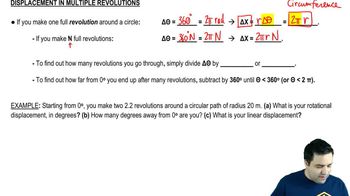An object moves a total distance of 1,000 m around a circle of radius 30 m. How many degrees does the object go through?
BONUS:How many complete revolutions does it make?
 Verified step by step guidance
Verified step by step guidance Verified video answer for a similar problem:
Verified video answer for a similar problem:



 14:3m
14:3mMaster Rotational Position & Displacement with a bite sized video explanation from Patrick
Start learning